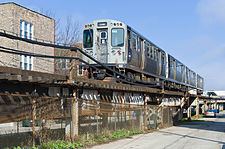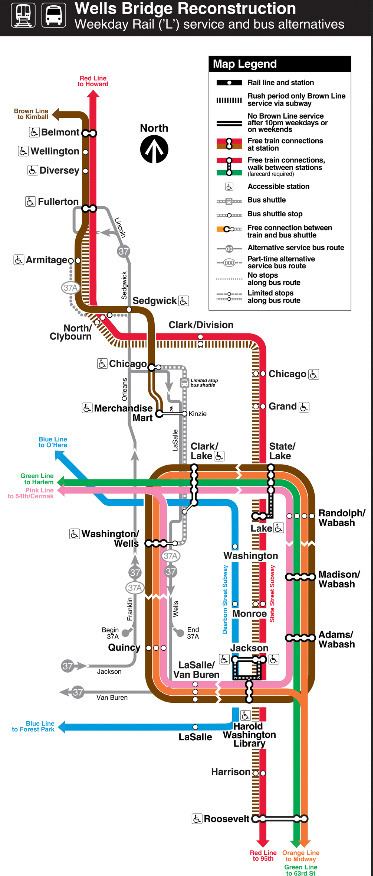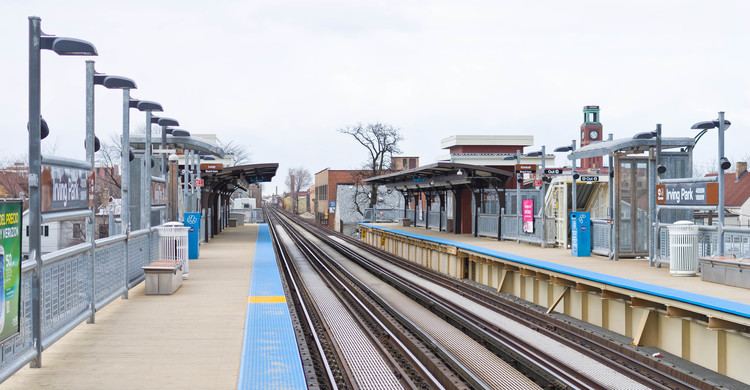Status Operational Locale Chicago | System Chicago "L" Stations 27 | |
 | ||
Daily ridership 101,881 (avg. weekday in 2011) Opened August 1, 1949 (Current operation) Character Elevated and Street Level | ||
The Brown Line (or the Ravenswood Line) of the Chicago "L" system, is an 11.4-mile (18.3 km) route with 27 stations between Chicago's Albany Park neighborhood and downtown Chicago. It runs completely above ground and is almost entirely grade-separated. It is the third busiest 'L' route, with an average of 101,881 passengers boarding each weekday in 2011.
Contents

The Brown Line operates to the Loop weekdays and Saturdays from 4:00 am to 1:30 am and on Sundays from 5:00 am to 1:30 am. The Brown Line Shuttle service, running only between Kimball and Belmont, runs from 4:00 am to 2:20 am on weekdays and Saturdays, and 5:00 am to 2:00 am on Sundays. At Belmont, southbound riders can transfer to the 24-hour Red Line.

Before CTA lines were color-coded in 1993, the Brown Line was known as the Ravenswood Route; specifically, the series of stations from Belmont to Kimball were called the Ravenswood branch. Accordingly, the Kimball-Belmont shuttle service was called the Ravenswood Shuttle.

Operation

The Brown Line begins on the northwest side of Chicago, at the Kimball terminal in Albany Park, where there is a storage yard and servicing shop for the trains to the east of the passenger station. From there, trains operate over street level tracks between Leland and Eastwood Avenues to Rockwell Street, then ramp up to the elevated structure for the rest of the trip.

The trains on the street-level section are powered by third rail rather than overhead catenary (the technology used by most other U.S. electric-powered at-grade rail systems), a decision that exposes wayward pedestrians to the risk of electrocution. A fatal accident in 1977 involving a severely intoxicated Korean immigrant who attempted to urinate on the third rail at the Kedzie station eventually resulted in a famous Illinois Supreme Court decision in 1992 affirming a verdict of $1.5 million against CTA.

After the Damen station, the route turns south, about one-half block parallel and west of Metra's Union Pacific North railroad line and Ravenswood Avenue to a point south of the Addison station. Here the route turns east again and runs parallel to Roscoe Street past Sheffield Avenue where it once again turns south at Clark Junction to join the four-track North Side elevated line in Lakeview. From just north of Belmont station south to Armitage, Brown and Red Line trains operate side-by-side, with Purple Line Express trains sharing the tracks with the Brown Line during weekday rush hours. Brown and Purple Line trains run on the outermost tracks serving five stops, while Red Line trains run on the innermost tracks making only two stops.

South of the Armitage station, Brown and Purple Line trains continue southward towards the Chicago Loop on elevated tracks which zigzags its way through the neighborhoods of Lincoln Park and Near North Side stopping at Sedgwick and Chicago/Franklin. Running over Franklin, then Wells Street, a stop is made at the Merchandise Mart before crossing the Chicago River on the upper level of the Wells Street Bridge before joining the Loop Elevated at Lake Street. Operating counterclockwise, Brown Line trains operate around the Loop on the Outer track via Wells-Van Buren-Wabash-Lake, serving all Loop stations, before the return trip back north to the Kimball terminal.
Rolling stock
The Brown Line is operated with the Morrison-Knudsen-built 3200-series railcars, delivered from 1992 through 1994, with one 2600-series railcar 3458, (renumbered from 3032). 2600-series railcars sometimes appear on the Brown Line when there is a shortage of 3200-series cars. However, the borrowing of 2600-series cars is no longer necessary as of December 2012 since Orange Line-assigned 2400-series cars (often in mixed eight car consists with that line's 3200-series cars) began operating selected weekday rush hour trips on the Brown Line due to a shortage in storage space at the Kimball Yard. The Orange Line's 2400-series cars have since been replaced by the 2600-series cars as of October 31, 2014. Still, one 2600-series car 3458, (renumbered from 3032) remains on the Brown Line. The Brown Line operate using four cars at other times on weekdays and all day on weekends and eight cars during weekday rush hours. The Brown Line's 3200-series cars are expected to remain in service on the line until at least the 2020s, where they will be replaced by the future 7000-series cars if all options are picked up, otherwise the Brown Line's 3200-series cars will remain in service on the line until the 2030s if the options are not picked up. In the meantime, CTA is currently in the process of overhauling the 3200-series cars with color LED destination signs (similar to the 5000-series cars), new air conditioning systems, and rebuilt propulsion systems, passenger door motors, and wheel/axle assemblies. The 3200-series rehabilitation began in 2015 and will be completed in 2017.
Beginning March 30, 2008, the Brown Line began running eight cars during rush hours, since all of the reopened or renovated stations have been rebuilt to accommodate eight cars. Prior to this, although ridership certainly warranted eight cars on the Brown Line during weekday rush hours, most stations on the line couldn't berth longer than six cars. Six cars are standard on the Brown Line during midday. Early morning, late evening, and weekend service is generally provided by four cars, although this may be extended to eight cars due to special events and holidays.
History
The Northwestern Elevated Railroad opened the Ravenswood branch between the existing main line and Western Avenue in Lincoln Square on May 18, 1907. The route was completed to the Kimball terminal on December 14, 1907.
The Kimball terminal was completely renovated and a new bridge over the North Branch of the Chicago River was completed in the 1970s. The Western and Merchandise Mart stations were rebuilt in the 1980s. Prior to the start of the Brown Line Capacity Expansion Project, these two stations, along with the Kimball terminal were the only ADA accessible stations on the Brown Line outside of the Loop.
Brown Line Capacity Expansion Project
The Brown Line Capacity Expansion Project—which ran from 2006 to 2009—was undertaken to repair aging infrastructure and increase passenger capacity at Brown Line stations. On February 20, 2006, the CTA broke ground on the project. All but one of the Brown Line stations were reconstructed to be ADA compliant and to accommodate eight-car trains. The right-of-way between Kimball and Rockwell Avenue was modernized. Traction power equipment and train control systems were upgraded and a new fiber optic communication network installed. Merchandise Mart was the only station not to receive any work as it had previously been reconstructed from 1987 to 1988, and was already ADA compliant and able to accommodate 8-car trains. Another two stations—Kimball and Western—received small platform extensions but little other work, and the other 16 stations were completely rebuilt.
The first two stations to be completed—Kedzie and Rockwell—reopened on August 16, 2006, and all of the stations had reopened by July 30, 2009 when the new Wellington station entered service. The project was completed on December 31, 2009.
